I normally don’t post images like these – taken in crappy light and in such an unattractive setting but when it comes to owls and interesting/amusing behaviors I’ll occasionally make an exception.
I often visit this metal hay barn just to check up on its resident Great Horned Owls though I seldom photograph them because of the poor light and unappealing metal backgrounds. But four days ago I couldn’t resist firing off a few shots because what I was seeing through the viewfinder amused me.
This adult was perched on a reinforcing cable that was so close to the roof that his head touched it and its ear tufts (“horns”) were scrunched down flat. The bird seemed to be making every effort to appear dignified and haughty but to my eye it failed miserably.
This is an adult of a mated pair on the right and a single fledgling perched on a narrow, metal beam.
As I watched them it became obvious that the adult wanted get past the youngster and move down the beam to the left.
The adult crouched down very low and tried to squeeze between the wall and the young bird but it must have realized that if it continued its effort there was danger of the fledgling being pushed off the edge of the beam so it…
very slowly and carefully backed up…
and then both birds looked at me before the adult…
chose another means to achieve its goal. It squatted down to take off…
and flew around the youngster and a vertical metal post just out of frame to the left.
It landed on the beam and then reappeared again as it moved closer to the young bird.
There’s more than one way to skin a cat…
Ron
Note: I’m curious about the right half of the tail feathers of the fledgling. They appear to be much lighter in color than the rest of the tail and I’m wondering if there isn’t some leucism going on. Any thoughts?


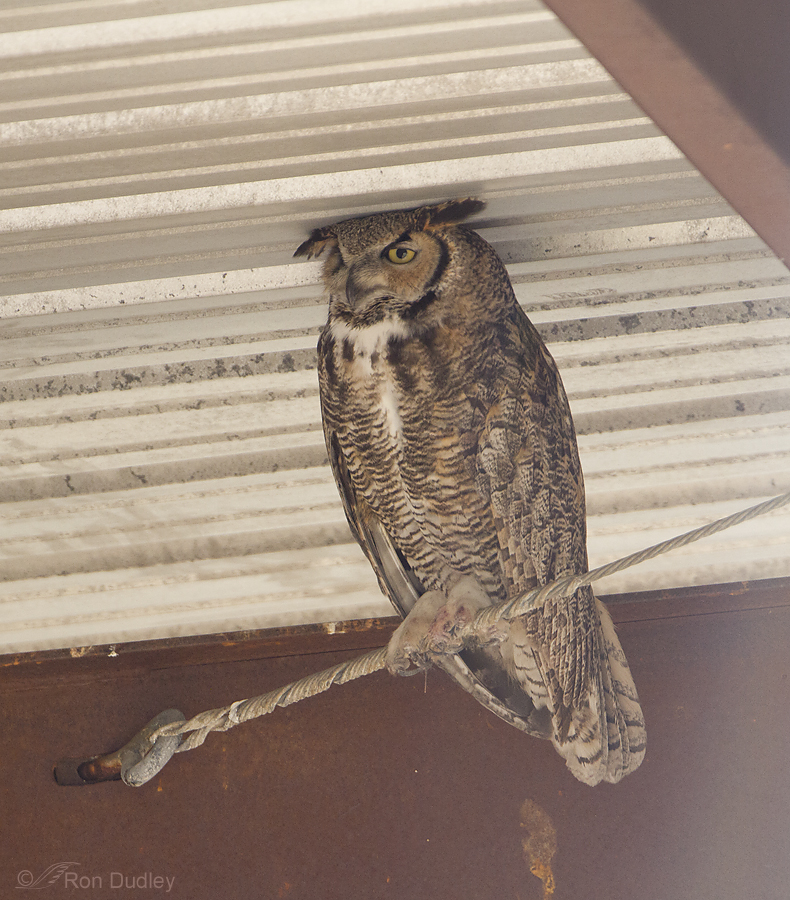

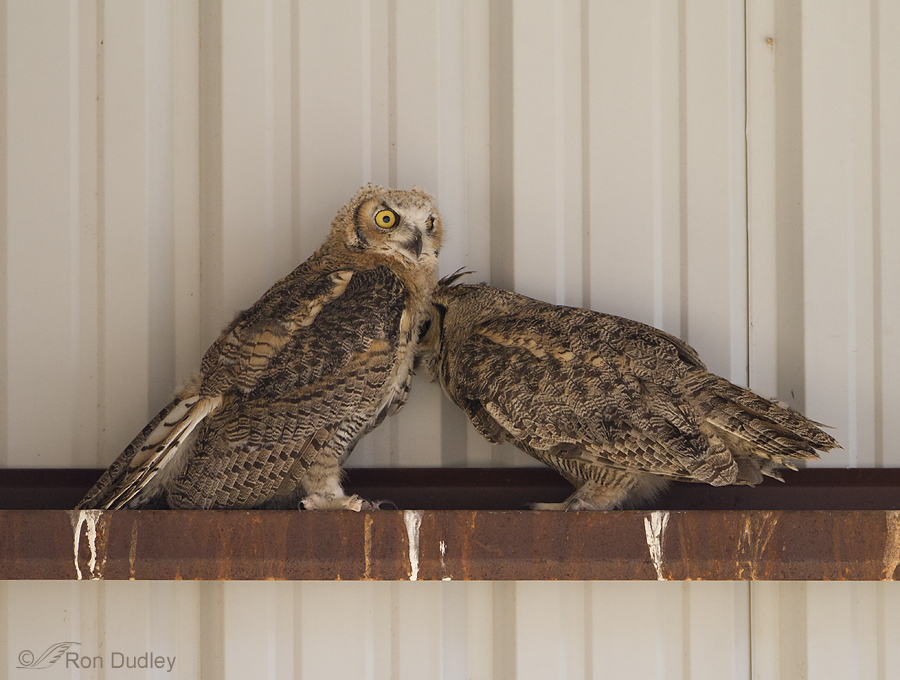
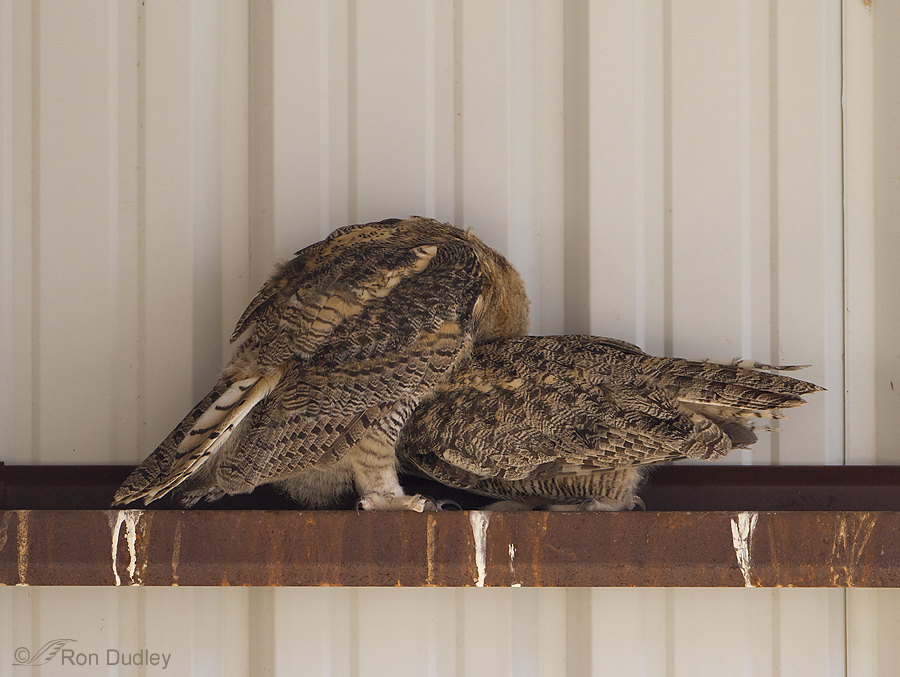
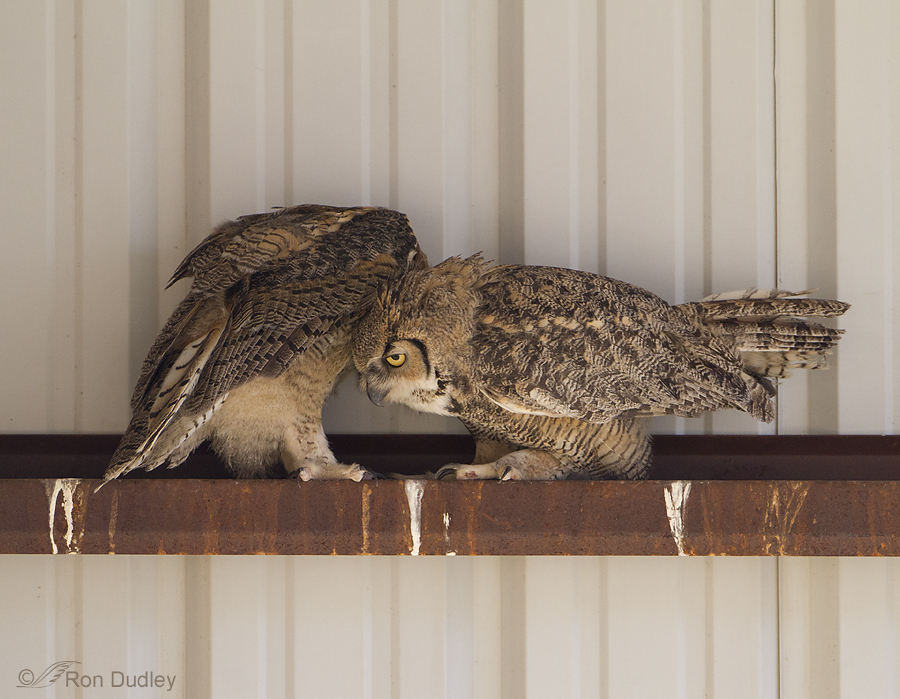
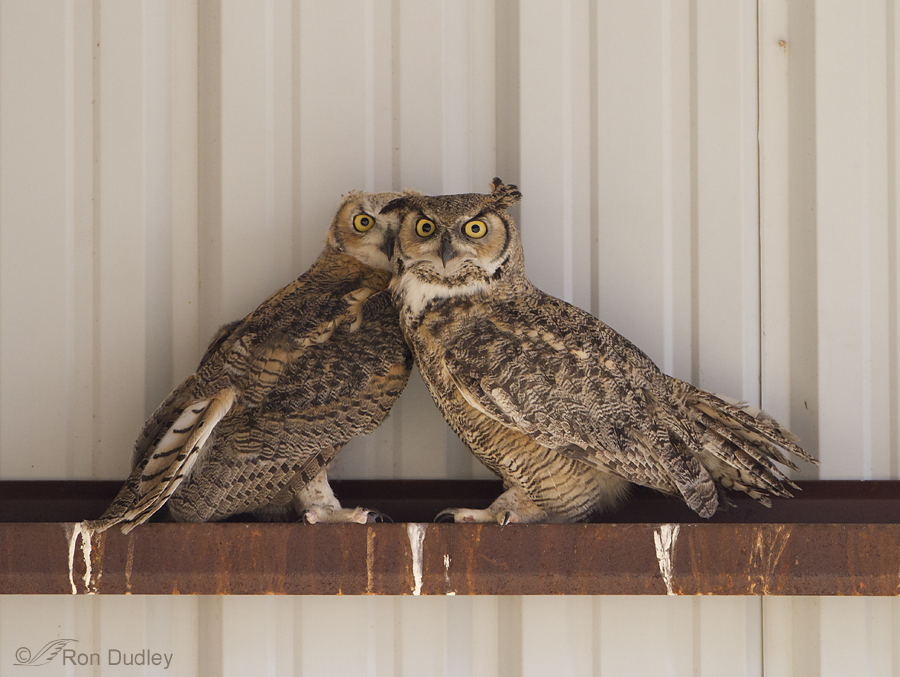
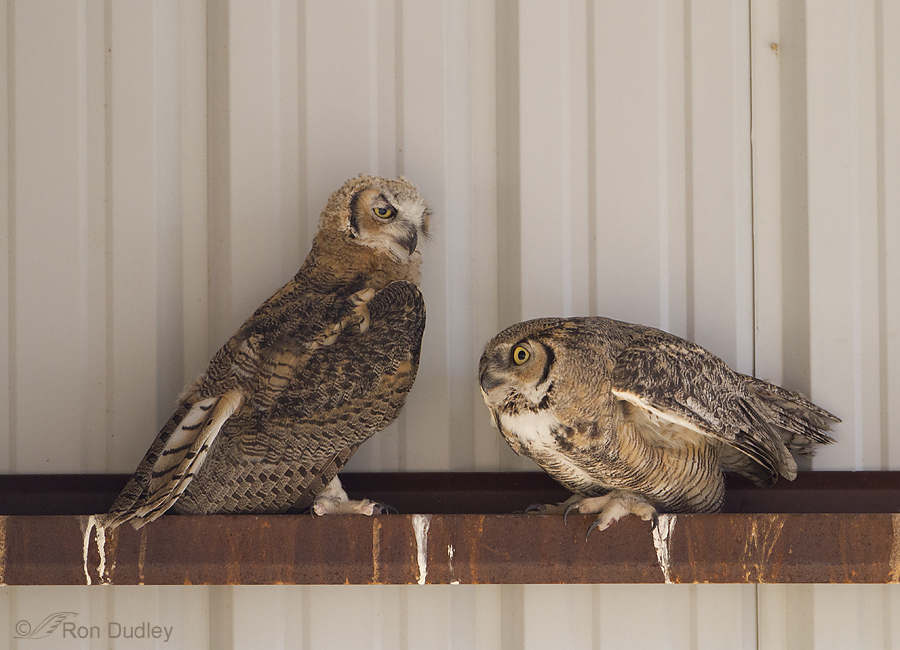
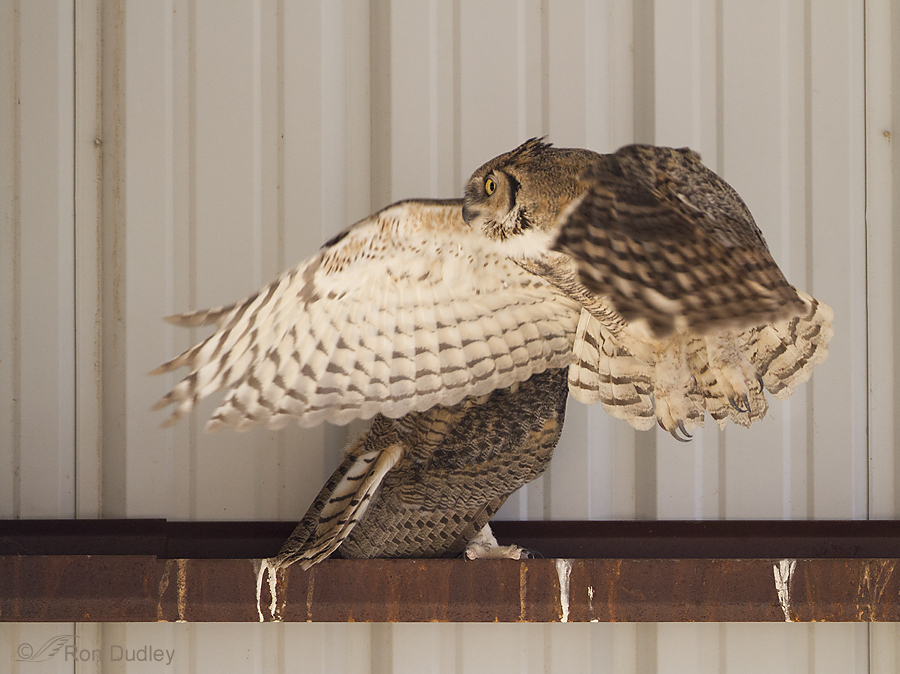
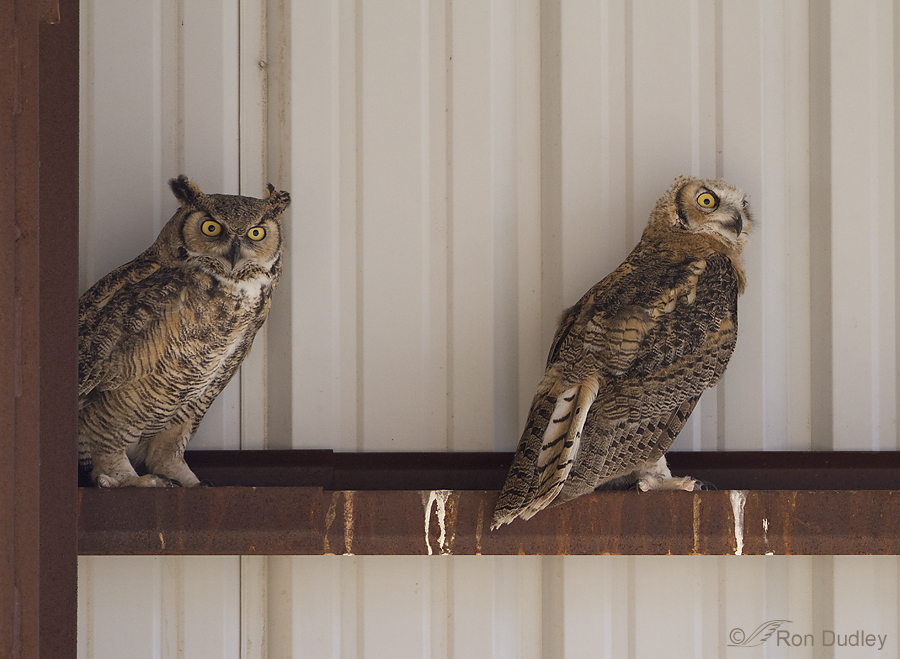
I’m seeing two rectrices that are out of position (not uncommon). Normally the rectrices are asymmetrical with the rachis not running down the center of the feather. So it is not uncommon for the wider (inner) portion of a tail feather to be slightly lighter than the outer portion (except for the two center rectrices, deck feathers) which normally lay on the top of all the other 10. In this case I’m seeing the second from outer rectrice being much lighter in coloration and possibly the outer having the same coloration. I would describe this as “dilute” rather than leucistic, although the pattern is quite different from the other rectrices. It would be hard to ascertain if this is a genetic issue, dietary issue, injury or stress issue. Having the feather(s) so uniform in color difference would suggest it is not stress related. I am unable to see the opposite half of the tail and see if the pattern is similar on that side (as those feathers would be growing/emerging at the same time). Interesting situation, though uncommon many raptors have been seen with plumage abnormalities. The visible feather is coloured much more like that of a Barn Owl than Great Horned.
I’m seeing two rectrices that are out of position (not uncommon). Normally the rectrices are asymmetrical with the rachis not running down the center of the feather. So it is not uncommon for the wider (inner) portion of a tail feather to be slightly lighter than the outer portion (except for the two center rectrices, deck feathers) which normally lay on the top of all the other 10. In this case I’m seeing the second from outer rectrice being much lighter in coloration and possibly the outer having the same coloration. I would describe this as “dilute” rather than leucistic, although the pattern is quite different from the other rectrices. It would be hard to ascertain if this is a genetic issue, dietary issue, injury or stress issue. Having the feather(s) so uniform in color difference would suggest it is not stress related. I am unable to see the opposite half of the tail and see if the pattern is similar on that side (as those feathers would be growing/emerging at the same time). Interesting situation, though uncommon many raptors have been seen with plumage abnormalities.
Oh. Oh my.
I am smiling so very broadly at this series. Thank you so much.
I agree that the scrunched horns do detract from the dignified pose – but he obviously wouldn’t agree. And I love the manoevering as well.
I am sure that Charlotte’s friend’s daughter will love your photos. Almost everyone I have sent a link from here to has become a happy follower.
What a wonderful series of photos! Getting to see such behavior is priceless. This is another set that made me smile and added a nice light note to my day.
I think I know the hay shed in question. And think I’m depressed after comparing my results to yours… Not knowing where your photos are taken always gave me a glimmer of hope that perhaps I’d get RD quality images should I be faced with the same scene. The balloon just burst. Ha! Stellar pics Ron.
Thank you, Mike. And yup, you do know that hay barn (shed). Close to the kestrel boxes we talked about…
Amazing and fantastic Ron! I’m passing your site on to a friend who has a daughter so she can see your work as well. Thanks so much!
Charlotte
Thank you, Charlotte. I hope your friend’s daughter enjoys the photos.
I love these shots! they bring back memories of theGH I raised..I’d almost forgotten how funny he was…very much like kitten in some ways,liked to pounce on the toys I dragged around for him, whinnied like a miniature horse, and his expressions were wonderful…they can look so indignant. We used to have long whoo whoo whoo whooooo whoooo conversations as he matured. Those light colored tail feathers are new to me.b but pretty…so are the lighter facial feathers….maybe I just don’t remember that well. Thanks for the smile and good memories.
Sounds like you had a lot of fun with that owl, Patty.
Hi Ron,
It looks like the outermost feather on the right is on top of the adjacent feather rather than under it as it would normally be. This lets you see the lighter portion of the feather that is normally hidden. I think this accounts for the color difference. Once the bird preens them all back into place, I would think it would be normal coloration. Just my two cents worth.
Mark
You’re probably right, Mark. However, I saw this juvenile again this morning and the tail looks the same as it did yesterday morning. Wouldn’t one expect that the preening would have been done by now? Thank you once again for your expertise on stuff like this!